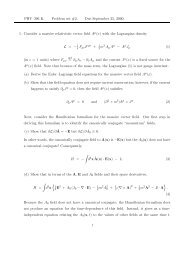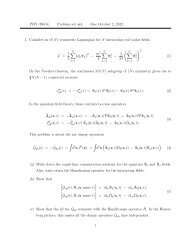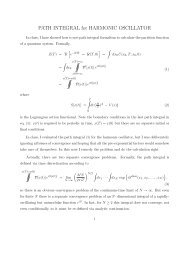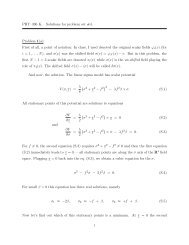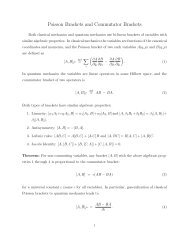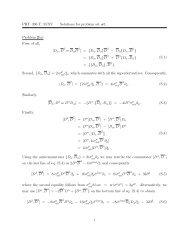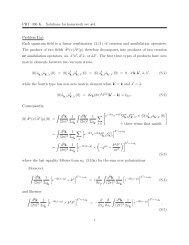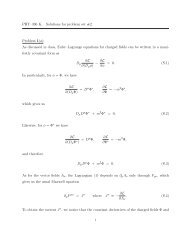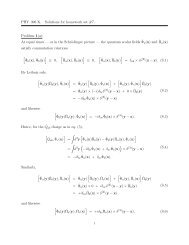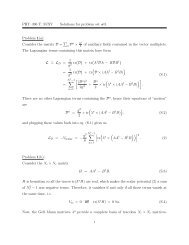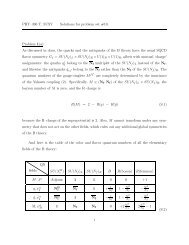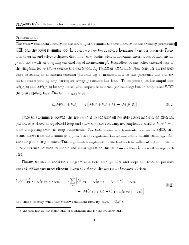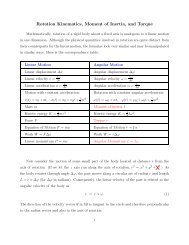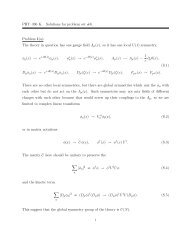PHYâ396 K. Problem set #5. Due October 13, 2011. 1. First, an ...
PHYâ396 K. Problem set #5. Due October 13, 2011. 1. First, an ...
PHYâ396 K. Problem set #5. Due October 13, 2011. 1. First, an ...
You also want an ePaper? Increase the reach of your titles
YUMPU automatically turns print PDFs into web optimized ePapers that Google loves.
PHY–396 K. <strong>Problem</strong> <strong>set</strong> <strong>#5.</strong> <strong>Due</strong> <strong>October</strong> <strong>13</strong>, <strong>201<strong>1.</strong></strong><br />
<strong>1.</strong> <strong>First</strong>, <strong>an</strong> exercise in Dirac matrices γ µ . Please do not assume <strong>an</strong>y specific form of these<br />
4 × 4 matrices, just use the <strong>an</strong>ti-commutation relations<br />
γ µ γ ν + γ ν γ µ = 2g µν . (1)<br />
In class, I have defined the spin matrices<br />
S µν = −S νµ def<br />
= i 4 [γµ , γ ν ] (2)<br />
<strong>an</strong>d showed that<br />
[<br />
S µν , γ λ] = ig νλ γ µ − ig µλ γ ν . (3)<br />
(a) Show that the spin matrices S µν have commutation relations of the Lorentz generators,<br />
[<br />
S κλ , S µν] = ig λµ S κν − ig λν S κµ − ig κµ S λν + ig κν S λµ . (4)<br />
A continuous Lorentz tr<strong>an</strong>sform obtains from integrating infinite sequences of infinitesimal<br />
tr<strong>an</strong>sforms X ′µ = X µ + ɛ Θ µ νX ν for <strong>an</strong>tisymmetric Θ µν = −Θ νµ (when both indices are<br />
down or both up); the finite tr<strong>an</strong>sform is X ′µ = L µ νX ν where<br />
L = exp(Θ), i. e., L µ ν = δ µ ν + Θ µ ν + 1 2 Θµ λ Θλ ν + 1 6 Θµ κΘ κ λ Θλ ν + · · · . (5)<br />
(b) Let L be a Lorentz tr<strong>an</strong>sform of the form (5), <strong>an</strong>d let M D<br />
(L) = exp ( − i 2 Θ αβS αβ) .<br />
Show that MD −1 (L)γµ M D<br />
(L) = L µ νγ ν .<br />
Hint: use Hadamard Lemma e A Be −A = B+[A, B]+<br />
2 1[A, [A, B]]+ 1 6<br />
[A, [A, [A, B]]]+· · ·.<br />
Next, a little more algebra:<br />
(c) Calculate {γ ρ , γ λ γ µ γ ν }, [γ ρ , γ κ γ λ γ µ γ ν ] <strong>an</strong>d [S ρσ , γ λ γ µ γ ν ].<br />
(d) Show that γ α γ α = 4, γ α γ ν γ α = −2γ ν , γ α γ µ γ ν γ α = 4g µν , <strong>an</strong>d γ α γ λ γ µ γ ν γ α =<br />
−2γ ν γ µ γ λ .<br />
Hint: use γ α γ ν = 2g να − γ ν γ α repeatedly.<br />
1
2. Now consider the γ 5 def = iγ 0 γ 1 γ 2 γ 3 matrix.<br />
(a) Show that γ 5 <strong>an</strong>ticommutes with each of the γ µ matrices — γ 5 γ µ = −γ µ γ 5 — <strong>an</strong>d<br />
commutes with all the spin matrices S µν .<br />
(b) Show that γ 5 is hermiti<strong>an</strong> <strong>an</strong>d that (γ 5 ) 2 = <strong>1.</strong><br />
(c) Show that γ 5 = (i/24)ɛ κλµν γ κ γ λ γ µ γ ν <strong>an</strong>d γ [κ γ λ γ µ γ ν] = −24iɛ κλµν γ 5 .<br />
(d) Show that γ [λ γ µ γ ν] = −6iɛ κλµν γ κ γ 5 .<br />
(e) Show that <strong>an</strong>y 4 × 4 matrix Γ is a unique linear combination of the following 16<br />
matrices: 1, γ µ , 1 2 γ[µ γ ν] , γ 5 γ µ , <strong>an</strong>d γ 5 .<br />
∗ My conventions here are: ɛ 0123 = −1, ɛ 0123 = +1, γ [µ γ ν] = γ µ γ ν − γ ν γ µ ,<br />
γ [λ γ µ γ ν] = γ λ γ µ γ ν − γ λ γ ν γ µ + γ µ γ ν γ λ − γ µ γ λ γ ν + γ ν γ λ γ µ − γ ν γ µ γ λ , etc.<br />
Now consider Dirac matrices in spacetime dimensions d ≠ 4. Such matrices always satisfy<br />
the Clifford algebra (1), but their sizes depend on d.<br />
Let Γ = i n γ 0 γ 1 · · · γ d−1 be the generalization of the γ 5 to d dimensions; the pre-factor<br />
i n = ±i or ±1 is chosen such that Γ = Γ † <strong>an</strong>d Γ 2 = +<strong>1.</strong><br />
(f) For even d, Γ <strong>an</strong>ticommutes with all the γ µ . Prove this, <strong>an</strong>d use this fact to show that<br />
there are 2 d independent products of the γ µ matrices, <strong>an</strong>d consequently the matrices<br />
should be 2 d/2 × 2 d/2 .<br />
(g) For odd d, Γ commutes with all the Γ µ — prove this. Consequently, one c<strong>an</strong> <strong>set</strong> Γ = +1<br />
or Γ = −1; the two choices lead to in-equivalent <strong>set</strong>s of the γ µ .<br />
Classify the independent products of the γ µ for odd d <strong>an</strong>d show that their net number<br />
is 2 d−1 ; consequently, the matrices should be 2 (d−1)/2 × 2 (d−1)/2 .<br />
3. Let’s go back to d = 3 + <strong>1.</strong> Since all the spin matrices S µν commute with the γ 5 , all the<br />
M D<br />
(L) = exp ( −<br />
2 i Θ αβS αβ) matrices are block-diagonal in the eigenbasis of the γ 5 . In the<br />
Weyl convention for the γ matrices,<br />
( )<br />
ML (L) 0<br />
M D (L) =<br />
(6)<br />
0 M R (L)<br />
where all blocks are 2 × 2. This makes the Dirac spinor a reducible representation of the<br />
continuous Lorentz group SO + (3, 1).<br />
2
Write down the explicit S µν matrices in the Weyl convention, then use them to show that<br />
the M L (L) block in eq. (6) is precisely the SL(2, C) matrix M from problem 4 of the<br />
last homework while the M R block is the M = ( M †) −1 = σ2 M ∗ σ 2 matrix from the same<br />
problem. In particular, for a pure rotation through <strong>an</strong>gle ϕ around axis n<br />
M L = M R = exp(−<br />
2 i ϕ n · σ). (7)<br />
while for a pure boost of rapidity r in the direction n, M L = exp(−<br />
2 r n · σ) but M R =<br />
exp(+<br />
2 r n · σ); in terms of the boost’s β <strong>an</strong>d γ parameters,<br />
M L = √ γ × √ 1 − β n · σ , M R = √ γ × √ 1 + β n · σ . (8)<br />
4. Finally, consider the pl<strong>an</strong>e-wave solutions e −ipx u(p, s) <strong>an</strong>d e +ipx v(p, x) of the Dirac equation.<br />
The 4–component spinors u(p, s) <strong>an</strong>d v(p, s) satisfy<br />
(̸p − m)u(p, s) = 0, (̸p + m)v(p, s) = 0, u † (p, s)u(p, s ′ ) = v † (p, s)v(p, s ′ ) = 2Eδ s,s<br />
′ .<br />
(9)<br />
Let’s writing down explicit formulae for these spinors in the Weyl basis for the γ µ matrices.<br />
(a) Show that for p = 0,<br />
u(p = 0, s) =<br />
( √ )<br />
m ξs<br />
√ m ξs<br />
(10)<br />
where ξ s is a two-component SO(3) spinor encoding the electron’s spin state. The ξ s<br />
are normalized to ξ † sξ s<br />
′ = δ s,s ′.<br />
(b) For other momenta, u(p, s) = M(boost)u(p = 0, s) for the boost that turns (m,⃗0) to<br />
p µ . Use eqs. (8) to show that<br />
u(p, s) =<br />
( √ )<br />
E − p · σ ξ s<br />
√ . (11)<br />
E + p · σ ξ s<br />
(c) Use similar arguments to show that<br />
v(p, s) =<br />
( √ )<br />
+ E − p · σ η s<br />
− √ E + p · σ η s<br />
(12)<br />
where η s are two-component SO(3) spinors normalized to η † sη s<br />
′ = δ s,s ′.<br />
3
Physically, the η s should have opposite spins from ξ s — the holes in the Dirac sea have<br />
opposite spins (as well as p µ ) from the missing negative-energy particles. Mathematically,<br />
this requires η sSη † s = −ξ sSξ † s ; we may solve this condition by letting η s = σ 2 ξs ∗ = ±iξ −s .<br />
(d) Check that this is a solution, then show that it leads to v(p, s) = γ 2 u ∗ (p, s).<br />
(e) Show that for ultra-relativistic electrons or positrons of definite helicity λ = ± 1 2 , the<br />
Dirac pl<strong>an</strong>e waves become chiral — i.e., dominated by one of the two irreducible<br />
components 2 or ¯2 of the Dirac spinor 2 ⊕ ¯2 while the other component becomes<br />
negligible. (The 2 component is the left-h<strong>an</strong>ded Weyl spinor while the ¯2 component<br />
is the right-h<strong>an</strong>ded Weyl spinor. I shall discuss them later in class.) Specifically,<br />
u(p, −<br />
2 1) ≈ √ ( )<br />
ξL<br />
2E , u(p, + 1 2<br />
0<br />
) ≈ √ ( )<br />
0<br />
2E ,<br />
ξ R<br />
( )<br />
0<br />
v(p, − 1 2 ) ≈ −√ 2E , v(p, + 1 2<br />
η ) ≈ √ ( )<br />
ηR<br />
2E .<br />
L<br />
0<br />
(<strong>13</strong>)<br />
Note that for electrons the left/right chirality is same as the helicity, but for positrons<br />
the chirality is opposite from the helicity.<br />
Finally, let’s establish some basis-independent properties of the Dirac spinors u(p, s) <strong>an</strong>d<br />
v(p, s) — although you may use the Weyl basis to verify them.<br />
(f) Show that<br />
ū(p, s)u(p, s ′ ) = +2mδ s,s<br />
′ , ¯v(p, s)v(p, s ′ ) = −2mδ s,s<br />
′ ; (14)<br />
note that the normalization here is different from eq. (9) for the v † u <strong>an</strong>d v † v.<br />
(g) There are only two independent SO(3) spinors, hence ∑ s ξ sξ † s = ∑ s η† sη s = 1 2×2 . Use<br />
this fact to show that<br />
∑<br />
s=1,2<br />
u α (p, s)ū β (p, s) = (̸p+m) αβ<br />
<strong>an</strong>d<br />
∑<br />
s=1,2<br />
v α (p, s)¯v β (p, s) = (̸p−m) αβ . (15)<br />
4



